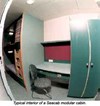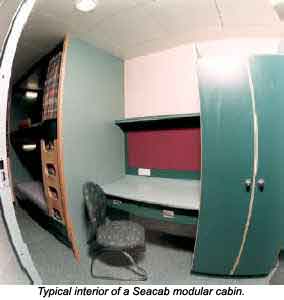New Accommodation Modules Meet HSE & CEN Regulations

Ferguson Seacabs' new modules were commissioned in order to meet the expected demand for higher industry standards following the recent introduction of new regulations by the UK Health & Safety Executive (HSE) and the European Committee for Standardization (CEN - Comité European de Normalisation). At the core of these regulations are the requirements for stronger build specifications and improved welfare standards for offshore workers.
The six modules, developed at the company's headquarters in Inverurie, Scotland, are designed and manufactured to comply with recent changes in the HSE requirements for offshore accommodation, effective as of 1st July 1999. In line with these requirements, individuals will now be accommodated in a minimum standard of two berth cabins with enhanced living space and better access to sanitary facilities, all providing improved levels of privacy and comfort.

The modules also comply with the latest European regulations, BS EN 12079 and DNV 2.7-1, relating to the lifting and handling of offshore containers and modules. These regulations stipulate that containers and modules must have sufficient strength to allow loading and unloading from offshore supply vessels operating in a sea state with significant wave heights of up to 6m. The load-bearing profile walls of traditional modules also had to be modified so that the strength of the module depended on the truss supports within the walls instead of the cladding.
In order that the changes did not result in significantly heavier modules, innovative design changes were made to the structure of the modules so that, despite the new, more onerous regulations, Ferguson Seacabs modules are, at 13 tons, 1.5 tons lighter.
The final module layout adopted by Ferguson Seacabs to comply with both the HSE and CEN standards is based on two two-man cabins and one central access space. Each cabin also contains an en-suite shower, toilet and washroom facility. The Ferguson Seacabs design allows the modules either to be used in stand-alone mode or to be assembled into a multi-module complex capable of accommodation several hundred people where required. If a client plans to use the units outside the North Sea, each cabin can be modified by adding a further two bunks, effectively doubling each module's capacity.
At present six modules have been manufactured to meet the immediate needs of clients who need to accommodate workers at short notice, especially during the summer hook-up and maintenance season. The modules can also be used to accommodate workers while upgrades are made to existing accommodation facilities to bring them into line with the new regulations.
On the completion of the new temporary accommodation modules, Gary Wilson, Module Rental Project Manager at Ferguson Seacabs said, "Standards for offshore accommodation have risen significantly over the last ten years as our clients recognize the bottom line benefits of providing better accommodation for offshore staff and strive to improve their existing facilities. These new modules meet the standards required by our clients and the HSE and provide maximum space and comfort in a compact unit. They offer a very high standard of temporary rental accommodation for clients, either engaged on maintenance campaigns or looking to upgrade their own permanent living quarters to the specifications required by the industry."
Edited by Dev George
